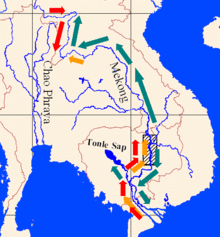Iridescent shark
![]()
This article is about the fish species Pangasius, for the fish genus of the same name see Pangasius (genus).
The pangasius (Pangasianodon hypophthalmus) is a freshwater fish in the shark catfish or slender catfish family (Pangasiidae) that inhabits the Mekong and Mae Nam Chao Phraya (Chao Phraya River) river systems in Thailand, Vietnam, Laos, and Cambodia.
Traditionally, the species is fished, but for some years it has also been increasingly farmed in aquacultures in Southeast Asia and marketed worldwide as food fish. Total production is over one million tons per year. Much of this is exported to Europe, where the fish is popular because of its low price and its flesh, which is described as mild-tasting. The German name used is that of the genus Pangasius, to which the species was formerly assigned. The species epithet hypophthalmus (from ancient Greek ὑπό hypó "under" as well as ὀφθαλμός ophthalmós "eye") refers to the low position of the eyes compared to the mouth.
Features
The pangasius has the scaleless, elongated body typical of the shark catfish (Pangasiidae). Adult animals reach a maximum weight of 44 kilograms at a length of up to 150 centimeters. They are dark grey with a lighter belly and dark grey to black fins. Very old and large animals become uniformly gray. As characteristic features of the genus Pangasianodon, the Pangasius has a terminal mouth (upper and lower jaws are therefore of equal length), a swim bladder with only one lobe and ventral fins with eight, rarely nine soft rays. In adults, the mouth is also toothless and the barbels on the lower jaw are missing. It differs from the other species of the genus, the Mekong Giant Catfish, by its much smaller size as well as the less broad head and the construction of the gill trap, which is well developed in the Pangasius and carries about 40 very short rays on the first arch between 15 longer rays.
The dorsal fin has, as in many catfish, a spiny hard ray followed by six branched soft rays. An adipose fin is present. The anal fin is elongated on the belly and has a black stripe in the middle, as do both lobes of the caudal fin. The small pelvic fins are located just in front of the anal fin.
Newly hatched individuals are yellowish and almost translucent with distinct barbels, while older juveniles resemble adults and have a black stripe along the lateral line organ and another just below. This pattern fades with age.
The chromosome set consists of 30 pairs (2n = 60).

Young animals with the typical stripe pattern
Occurrence
The species inhabits the major river courses of the Mekong and Mae Nam Chao Phraya (Chao Phraya River) in Thailand, Vietnam, Laos and Cambodia. The Mekong River occurrence is believed to be divided into a southern population in Cambodia and Vietnam and a northern population in Laos and Thailand by the waterfalls in the Lao province of Champasak. Catches in the area of the falls, however, indicate some exchange between populations. More detailed genetic studies are only available on the southern population, within which there are three co-occurring, genetically distinct subpopulations, possibly separated by different spawning seasons. The spawning area of the southern Mekong population is in a relatively small area in northern Cambodia between Kratie and the Mekong Falls; that of the northern and Chao Phraya populations is unknown.
In Bangladesh, Singapore and the Philippines, naturalized stocks exist as a result of the introduction to aquaculture. Here the species is considered ecologically very problematic due to its voracity and possible competition with native fish.

Hinterindien with Mekong and Chao Phraya as distribution area of the Pangasius, as well as migrations in the Mekong: Orange - March to May; Dark green - May to September; Red - October to February; Hatching - spawning areas of the southern Mekong population
Search within the encyclopedia